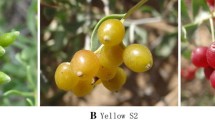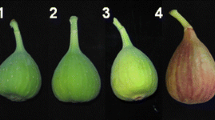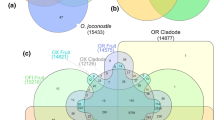Abstract
We conducted an exhaustive study of gene expression in fig fruits to identify the gene complexes responsible for fundamental fruit physiology and phenotypic differences between ecotypes. We performed high-throughput pyrosequencing on cDNA libraries constructed from caprifig and common fig fruits and compared their transcriptomes by analyzing the expressed sequence tags obtained. We collected a total of 290,594 expressed sequence tag reads from the two fruit types and assembled them into 71,455 unigenes (19,166 contigs and 52,289 singletons). We identified many metabolic genes, including those encoding proteins in the ethylene, glucose, and anthocyanin synthesis pathways that are involved in fruit maturation. This set also contained unigenes with unidentified functions. We observed no significant differences between the fruit types with respect to Gene Ontology term representation. By reverse transcription polymerase chain reaction, however, we detected several polymorphisms at the level of individual genes. Inter-type variations with respect to the expression level or transcription product size were observed in B- and C-class MADS-box gene homologs and chalcone synthase homologs, which are believed to be involved in sexuality and parthenocarpy, respectively. Expression polymorphisms were also observed for other genes, including a gibberellin-regulated protein gene. Our data and results contribute to genetic research on fig fruits and will aid in the understanding of fruit physiology and mechanisms of phenotypic differentiation.









Similar content being viewed by others
References
Adams-Phillips L, Barry C, Giovannoni J (2004) Signal transduction systems regulating fruit ripening. Trends Plant Sci 9:331–338. doi:10.1016/j.tplants.2004.05.004
Ainsworth C, Crossley S, Buchanan-Wollaston V, Thangavelu M, Parker J (1995) Male and female flowers of the dioecious plant sorrel show different patterns of MADS box gene expression. Plant Cell 10:1583–1598. doi:10.1105/tpc.7.10.1583
Alagna F, D’Agostino N, Torchia L, Servili M, Rao R, Pietrella M, Giuliano G, Chiusano ML, Baldoni L, Perrotta G (2009) Comparative 454 pyrosequencing of transcripts from two olive genotypes during fruit development. BMC Genomics 10:399. doi:10.1186/1471-2164-10-399
Alba R, Payton P, Fei Z, McQuinn R, Debbie P, Martin GB, Tanksley SD, Giovannoni JJ (2005) Transcriptome and selected metabolite analyses reveal multiple points of ethylene control during tomato fruit development. Plant Cell 17:2954–2965. doi:10.1105/tpc.105.036053
Altschul SF, Gish W, Miller W, Myers EW, Lipman DJ (1990) Basic local alignment search tool. J Mol Biol 215:403–410
Awamura M, Shoda K, Yahata D (1996) Effect of various seed parents on frequency distribution of parthenocarpy among seedling progenies of fig (Ficus carica L.). J Japan Soc Hort Sci 65:21–26. doi:10.2503/jjshs.65.21
Barakat A, DiLoreto DS, Zhang Y, Smith C, Baier K, Powell WA, Wheeler N, Sederoff R, Carlson JE (2009) Comparison of the transcriptomes of American chestnut (Castanea dentata) and Chinese chestnut (Castanea mollissima) in response to the chestnut blight infection. BMC Plant Biol 9:51. doi:10.1186/1471-2229-9-51
Beck NG, Load EM (1988) Breeding system in Ficus carica, the common fig. II. Pollination events. Am J Bot 75:1913–1922
Bellin D, Ferrarini A, Chimento A, Kaiser O, Levenkova N, Bouffard P, Delledonne M (2009) Combining next-generation pyrosequencing with microarray for large scale expression analysis in non-model species. BMC Genomics 10:555. doi:10.1186/1471-2164-10-555
Bouzayen M, Latché A, Nath P, Pech JC (2010) Mechanism of fruit ripening. In: Pua EC, Davey MR (eds) Plant developmental biology—biotechnological perspectives, 1st edn. Springer, Heidelberg, pp 319–339
Busch MA, Bomblies K, Weigel D (1999) Activation of a floral homeotic gene in Arabidopsis. Science 285:585–587. doi:10.1126/science.285.5427.585
Chessa I (1997) In: Mitra S (ed) Postharvest physiology and storage of tropical and subtropical fruits. CAB International, Wallingford, pp 245–268
Crane JC, Bradley MV, Luckwill LC (1959) Auxins in parthenocarpic and non-parthenocarpic figs. J HortSci 34:142–153
Datwyler SL, Weiblen GD (2004) On the origin of the fig: phylogenetic relationships of Moraceae from ndhF sequences. Am J Bot 91:767–777. doi:10.3732/ajb.91.5.767
Del Caro A, Piga A (2008) Polyphenol composition of peel and pulp of two Italian fresh fig fruits cultivars (Ficus carica L.). Eur Food Res Technol 226:715–719. doi:10.1007/s00217-007-0581-4
Dellaporta SL, Calderon-Urrea A (1993) Sex determination in flowering plants. Plant Cell 5:1241–1251. doi:10.1105/tpc.5.10.1241
DeYoung BJ, Innes RW (2006) Plant NBS-LRR proteins in pathogen sensing and host-defense. Nature Imm 7:1243–1249. doi:10.1038/ni1410
Drews GN, Bowman JL, Meyerowitz ΕΜ (1991) Negative regulation of the Arabidopsis homeotic gene by the apetala2 product. Cell 65:991–1002. doi:10.1016/0092-8674(91)90551-9
Duenas M, Perez-Alonso JJ, Santos-Buelga C, Escribano-Bailon T (2008) Anthocyanin composition in fig (Ficus carica L.). J Food Composit Anal 21:107–115. doi:10.1016/j.jfca.2007.09.002
Elo A, Lemmetyinen J, Turunen M, Tikka L, Sopanen T (2001) Three MADS-box genes similar to APETALA1 and FRUITFULL from silver birch (Betula pendula). Physiol Plant 112:95–103. doi:10.1034/j.1399-3054.2001.1120113.x
Ersoy N, GözlekçiŞ KL (2007) Changes in sugar contents of fig fruit (Ficus carica Cv. Bursa Siyahi) during development. Süleyman Demirel Üniversitesi Ziraat Fakültesi Dergisi 2:22–26
FAO: Food and Agriculture Organization of the United Nations (2006) FAOSTAT agricultural data. http://faostat.fao.org/site/408/default.aspx. Accessed 13 July 2012
Ferrario SIT, Immink RGH, Shchennikova A, Busscher-Lange J, Angenent GC (2003) The MADS box gene FBP2 is required for the SEPALLATA function in petunia. Plant Cell 15:914–925. doi:10.1105/tpc.010280
Galil J (1977) Fig biology. Endeavour 1:52–56
Garg R, Patel RK, Jhanwar S, Priya P, Bhattacharjee A, Yadav G, Bhatia S, Chattopadhyay D, Tyagi AK, Jain M (2011) Gene discovery and tissue-specific transcriptome analysis in chickpea with massively parallel pyrosequencing and web resource development. Plant Physiol 156:1661–1678. doi:10.1104/pp.111.178616
Giovannoni JJ (2004) Genetic regulation of fruit development and ripening. Plant Cell 16:S170–S180. doi:10.1105/tpc.019158
Golenberg EM, Freeman DC (2006) Environmental sex expression, sexual lability, biased sex ratios and other X-rated stories from the far-red side of the garden. In: da Silva JA T (ed) Floriculture, ornamental and plant biotechnology: advances and topical issues. Global Science Books, Ikenobe, pp 280–291
Gupta SM, Srivastava S, Sane AP, Nath P (2006) Differential expression of genes during banana fruit development, ripening and 1-MCP treatment: presence of distinct fruit specific, ethylene induced and ethylene repressed expression. Postharvest BiolTechnol 42:16–22. doi:10.1016/j.postharvbio.2006.05.002
Habu T, Yamane H, Igarashi K, Hamada K, Yano K, Tao R (2012) 454-pyrosequencing of the transcriptome in leaf and flower buds of Japanese apricot (Prunus mume Sieb. et Zucc.) at different dormant stages. J Japan Soc Hort Sci 81:239–250
Hanhineva K, Kokko H, Siljanen H, Rogachev I, Aharoni A, Kärenlampi S (2009) Stilbene synthase gene transfer caused alterations in the phenylpropanoid metabolism of transgenic strawberry (Fragaria × ananassa). J Exp Bot 60:2093–2106. doi:10.1093/jxb/erp085
Hardenack S, Ye D, Saedler H, Grant S (1994) Comparison of MADS box gene expression in developing male and female flowers of the dioecious plant white campion. Plant Cell 6:1775–1787. doi:10.1105/tpc.6.12.1775
Heslop-Harrison J (1964) Sex expression in flowering plants. In: Brookhaven National Laboratory (ed) Brookhaven symposia in biology. Brookhaven National Laboratory, Upton, New York, pp 109–125
Heuer S, Hansen S, Bantin J, Brettschneider R, Kranz E, Lorz H, Dresselhaus T (2001) The maize MADS box gene ZmMADS3 affects node number and spikelet development and is co-expressed with ZmMADS1 during flower development, in egg cells, and early embryogenesis. Plant Physiol 127:33–45. doi:10.1104/pp.127.1.33
Hu ZL, Bao J, Reecy JM (2008) CateGOrizer: a web-based program to batch analyze gene ontology classification categories. Online Journal of Bioinformatics 9:108–112
Ikegami H, Nogata H, Hirashima K, Awamura M, Nakahara T (2009a) Analysis of genetic diversity among European and Asian fig varieties (Ficus carica L.) using ISSR, RAPD, and SSR markers. Genet Resour Crop Evol 56:201–209. doi:10.1007/s10722-008-9355-5
Ikegami H, Koshita Y, Yakushiji H, Hirashima K, Hirata C, Nakahara T (2009b) Simple and efficient RNA extraction and gene analysis in vegetative organs of Japanese persimmon. Plant Biotechnol 26:427–429. doi:10.5511/plantbiotechnology.26.427
Ingrosso I, Bonsegna S, De Domenico S, Laddomada B, Blando F, Santino A, Giovinazzo G (2011) Over-expression of a grape stilbene synthase gene in tomato induces parthenocarpy and causes abnormal pollen development. Plant Physiol Biochem 49:1092–1099. doi:10.1016/j.plaphy.2011.07.012
Iseli C, Jongeneel CV, Bucher P (1999) ESTScan: a program for detecting, evaluating, and reconstructing potential coding regions in EST sequences. Proc Int Conf Intell Syst Mol Biol 138–148
Jurka J, Kapitonov VV, Pavlicek A, Klonowski P, Kohany O, Walichiewicz J (2005) Repbase Update, a database of eukaryotic repetitive elements. Cytogenetic and Genome Res 110:462–467. doi:10.1159/000084979
Kater M, Franken J, Carney K, Colombo L, Angenent G (2001) Sex determination in the monoecious species cucumber is confined to specific floral whorls. Plant Cell 13:481–493. doi:10.1105/tpc.13.3.481
Kesari R, Trivedi PK, Nath P (2007) Ethylene-induced ripening in banana evokes expression of defense and stress related genes in fruit tissue. Postharvest Biol Technol 6:136–143. doi:10.1016/j.postharvbio.2007.04.010
Kislev ME, Hartmann A, Bar-Yosef O (2006) Early domesticated fig in the Jordan Valley. Science 312:1372–1374. doi:10.1126/science.1125910
Klee HJ (2004) Ethylene signal transduction. Moving beyond Arabidopsis. Plant Physiol 135:660–667. doi:10.1104/pp.104.040998
Kobayashi S, Goto-yamamoto N, Hirochika H (2004) Retrotransposon-induced mutations in grape skin color. Science 304:98. doi:10.1126/science.1095011
Lodhi F, Bradley MV, Crane JC (1969) Auxins and gibberellin-like substances in parthenocarpic and non-parthenocarpic syconia of Ficus carica L., cv. King. Plant Physiol 44:555–561. doi:10.1104/pp.44.4.555
Lohmann JU, Hong RL, Hobe M, Busch MA, Parcy F, Simon R, Weigel D (2001) A molecular link between stem cell regulation and floral patterning in Arabidopsis. Cell 105:793–803. doi:10.1016/S0092-8674(01)00384-1
Mizukami Y, Ma H (1992) Ectopic expression of the floral homeotic gene agamous in transgenic Arabidopsis plants alters floral organ identity. Cell 71:119–131. doi:10.1016/0092-8674(92)90271-D
Mo Y, Nagel C, Taylor LP (1992) Biochemical complementation of chalcone synthase mutants defines a role for flavonols in functional pollen. Proc Nat Acad Sci USA 89:7213–7217
Nelson N (1999) Metal ion transporters and homeostasis. EMBO J 18:4361–4371. doi:10.1093/emboj/18.16.4361
Ohme-Takagi M, Shinshi H (1995) Ethylene-inducible DNA binding proteins that interact with an ethylene-responsive element. Plant Cell 7:173–182
Owino WO, Manabe Y, Mathooko FM, Kubo Y, Inaba A (2006) Regulatory mechanisms of ethylene biosynthesis in response to various stimuli during maturation and ripening in fig fruit (Ficus carica L.). Plant Physiol Biochem 44:335–342. doi:10.1016/j.plaphy.2006.03.009
Park HH, Ishikawa Y, Yoshida R, Kanno A, Kameya T (2003) Expression of AODEF, a B-functional MADS-box gene, in stamens and inner sepals of the dioecious species Asparagus officinalis L. Plant MolBiol 51:867–875. doi:10.1023/A:1023097202885
Ramirez BW (1974) Coevolution of Ficus and Agaonidae. Ann Mo Bot Gard 61:770–80
Riechmann JL, Heard J, Martin G, Reuber L, Jiang CZ, Keddie J, Adam L, Pineda O, Ratcliffe OJ, Samaha RR, Creelman R, Pilgrim M, Broun P, Zhang JZ, Ghandehari D, Sherman BK, Yu GL (2000) Arabidopsis transcription factors: genome-wide comparative analysis among eukaryotes. Science 290:2105–2110. doi:10.1126/science.290.5499.2105
Saleeb WF (1965) Genetics and cytology of syconium persistence in Ficus carica. Unpublished PhD thesis. University of California
Sather DN, Jovanovic M, Golenberg EM (2010) Functional analysis of B and C class floral organ genes in spinach demonstrates their role in sexual dimorphism. BMC Plant Biol 10:46. doi:10.1186/1471-2229-10-46
Schijlen EG, de Vos CH, Martens S, Jonker HH, Rosin FM, Molthoff JW, Tikunov YM, Angenent GC, van Tunen AJ, Bovy AG (2007) RNA interference silencing of chalconesynthase, the first step in the flavonoid biosynthesis pathway, leads to parthenocarpictomato fruits. Plant Physiol 144:1520–1530. doi:10.1104/pp.107.100305
Sheppard LA, Brunner A, Krutovskii K, Rottmann W, Skinner J, Vollmer S, Strauss SH (2000) A DEFICIENS homolog from the dioecious tree black cottonwood is expressed in female and male floral meristems of the two-whorled, unisexual flowers. Plant Physiol 124:627–640
Smit AFA, Hubley R, Green P (1996–2010) RepeatMasker Open-3.0. (http://www.repeatmasker.org). Accessed 10 Jan 2013
Solano R, Stepanova A, Chao QM, Ecker JR (1998) Nuclear events in ethylene signaling: atranscriptional cascade mediated by ETHYLENE-INSENSITIVE3 and ETHYLENERESPONSE-FACTOR1. Genes Dev 12:3703–3714
Solomon A, Golubowicz S, Yablowicz Z, Grossman S, Bergman M, Gottlieb HE, Altman A, Kerem Z, Flaishman MA (2006) Antioxidant activities and anthocyanin content of fresh fruits of common fig (Ficus carica L.). J Agri Food Chem 54:7717–7723. doi:10.1021/jf060497h
Storey WB (1975) Figs. In: Janick J, Moore JN (eds) Advances in fruit breeding. Purdue University Press, West Lafayette, pp 568–589
Stover E, Aradhya M, Ferguson L, Crisosto CH (2007) The fig: overview of an ancient fruit. Hortscience 42:1083–1087
The Gene Ontology Consortium (2000) Gene Ontology: tool for the unification of biology. Nature Genet 25:25–29. doi:10.1038/75556
Theissen G (2001) Development of floral organ identity: stories from the MADS house. Curr Opin Plant Biol 4:75–85. doi:10.1016/S1369-5266(00)00139-4
Theissen G, Saedler H (2001) Plant biology: floral quartets. Nature 409:469–471. doi:10.1038/35054172
Thomine S, Wang R, Ward JM, Crawford NM, Schroeder JI (2000) Cadmium and iron transport by members of a plant metal transporter family in Arabidopsis with homology to Nramp genes. Proc Nat Acad Sci USA 97:4991–4996. doi:10.1073/pnas.97.9.4991
Vinson JA, Zubik L, Bose P, Samman N, Proch J (2005) Dried fruits: excellent in vitro and in viva antioxidants. J Am Coll Nutr 24:44–50
Watkins CB (2002) Ethylene synthesis, mode of action, consequences and control. In: Knee M (ed) Fruit quality and its biological basis. Sheffield Academic Press, Sheffield, pp 180–224
Wiebes JT (1979) Co-evolution of figs and their insect pollinators. A Rev of Ecol Syst 10:1–12. doi:10.1146/annurev.es.10.110179.000245
Xie R, Zheng L, He S, Zheng Y, Yi S, Deng L (2011) Anthocyanin biosynthesis in fruit tree crops: genes and their regulation. African J Biotechnol 10:19890–19897. doi:10.5897/AJBX11.028
Yahata D, Nogata H (1999) Cultivar variations in sugar contents in fig syconia, their parts and nodal positions. J Japan Soc Hort Sci 68:987–992. doi:10.2503/jjshs.68.987
Yamaguchi T, Kurosaki F, Suh DY, Sankawa U, Nishioka M, Akiyama T, Shibuya M, Ebizuka Y (1999) Cross-reaction of chalcone synthase and stilbene synthase overexpressed in Escherichia coli. FEBS Lett 460:457–461
Yamaki S (2010) Metabolism and accumulation of sugars translocated to fruit and their regulation. J Japan Soc Hort Sci 79:1–15
Ylstra B, Busscher J, Franken J, Hollman PCH, Mol JNM, van Tunen AJ (1994) Flavonols and fertilization in Petunia hybrida: localization and mode of action during pollen tube growth. Plant J 6:201–6212. doi:10.1046/j.1365-313X.1994.6020201.x
Yu D, Kotilainen M, Pollanen E, Mehto M, Elomaa P, Helariutta Y, Albert V, Teeri T (1999) Organ identity genes and modified patterns of flower development in Gerbera hybrida (Asteraceae). Plant J 17:51–62. doi:10.1046/j.1365-313X.1999.00351.x
Ziegler H (1975) Nature of transported substances in the phloem. In: Zimmermann MH, Milburn JA (eds) Encyclopedia of plant physiology, NS Vol 1. Transport in Plants 1: Phloem Transport. Springer-Verlag, Berlin, pp 59–100
Acknowledgment
The authors would like to thank Edanz (http://www.edanzediting.co.jp/) for English language support.
Author information
Authors and Affiliations
Corresponding author
Additional information
Communicated by J. Wegrzyn
Data archiving statement
The sequence data generated in this study have been deposited at DDBJ in the Sequence Read Archive (DRA) and Transcriptome Shotgun Assembly (TSA) database under the accession number DRA000630 and FX376975-FX394131, respectively.
An erratum to this article is available at http://dx.doi.org/10.1007/s11295-015-0958-7.
Electronic supplementary material
Below is the link to the electronic supplementary material.
ESM 1
(PPT 208 kb)
Rights and permissions
About this article
Cite this article
Ikegami, H., Habu, T., Mori, K. et al. De novo sequencing and comparative analysis of expressed sequence tags from gynodioecious fig (Ficus carica L.) fruits: caprifig and common fig. Tree Genetics & Genomes 9, 1075–1088 (2013). https://doi.org/10.1007/s11295-013-0622-z
Received:
Revised:
Accepted:
Published:
Issue Date:
DOI: https://doi.org/10.1007/s11295-013-0622-z




